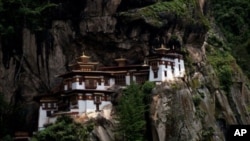Rising incomes across Asia in the last decade have helped create millions of new tourists, eager to explore foreign places.
Bhutan, an Asian nation that has seen relatively few international visitors, is hoping to dramatically boost its tourism industry and provide a vital jolt to its economy.
Keeping traditions
Guests are welcomed by a Bhutanese traditional song of greeting as they arrive at the hotel in the capital Thimphu.
The kingdom, with its snow capped ranges and forested valleys, is preparing to draw more travelers interested in its Mahayana Buddhist faith and traditional artwork, distinctive architecture, forested treks and crisp clean air.
With a population of just 700,000, Bhutan is braced between Asia’s giants of India and China. Officials here have long sought to protect local culture from the influence of foreign visitors.
Tshering Tobgay, a resort owner in Paro Valley, 55 kilometers from Thimphu, says avoiding the excesses of mass tourism that have damaged or overdeveloped other locations in Asia remains a priority.
“The government is taking a very good initiative to promote tourism in a way that we don’t want a lot of people in one go. So we focus on high value and low volume. It’s a very good concept - that is a small country, we don’t want a lot of tourists to come in and spoil our culture and heritage likewise in other countries,” said Tobgay.
Limiting numbers of tourists
The number of foreign visitors has steadily risen over the years. The kingdom drew 400 tourists when it opened its doors to visitors in 1974. Four decades later, the total has reached 60,000, and the government is expecting 100,000 visitors a year by 2013.
The country charges most foreign visitors an all-encompassing fee of about $250 per day, which covers transportation, guides, room and board. The fee is aimed at limiting the numbers of visitors and ensuring the country receives only ‘high value’ travelers. A third of the total fee is budgeted for Bhutan’s education and health services.
Bhutan’s main source of foreign exchange remains hydropower electricity sales to India. But Kesang Wangdi, director general of Bhutan’s Tourism Council, says tourism is set to play a key role in Bhutan’s development.
“Tourism occupies one of the key priorities and attention of the government because of its potential to contribute towards a more equitable socio-economic development in terms of alleviation of poverty issues and employment generation," he said. "This potential to economically empower people at the grass roots level.”
Managing visitors
But the increasing number of visitors presents challenges for the largely rural and mountainous country. While the outside visitors bring much-needed foreign currency for local businesses, they also place stress on the country’s infrastructure.
“There’s a lot of infrastructure that needs to be built to support 100,000 people coming in. You’ve got to look at that from airport facilities then hotels," said Julie Beattie, a resort manager in Paro. The thing is to make sure that the infrastructure is not all centered on certain places - that is actually is defused across the Kingdom.”
While proponents hope that infrastructure development will lift the lives of Bhutanese, there are already worries about its down side. Plastic bottles and other non-biodegradable waste in streams and along trekking paths are troubling some visitors, says Bhutan’s economics minister, Lyonpo Khandu Wangchak.
“We feel now - what began at this crossroads - many tourists told us that ‘if we don’t take care of the trash on the trekking routes or the waste in the cities - I don’t want to spend 250 dollars to see this rubbish’,” he said.
Handling growth
He says the industry’s success in Bhutan will largely depend on how the country handles that growth.
Buddhist prayer flags flutter violently at Che Li La Pass, 3,810 meters above Paro valley. Bhutan Tourism Council guide, Phuntsho Gyeltshen, says preserving the culture that exists in Bhutan now is key to its success as a destination.
“Bhutan is still one of those places we probably dream or wish to see at some point in our lives you know," he said. "So I think this could be one of those destinations one should try and visit once in their life time.”
Tourist officials says that so far, the small number of visitors has meant little need for stringent guidelines on managing tourists. But as the number of visitors rises, authorities say they need more serious legislation and regulations to ensure the visitors do not spoil the environment, culture and traditions that have drawn visitors from afar for decades.










